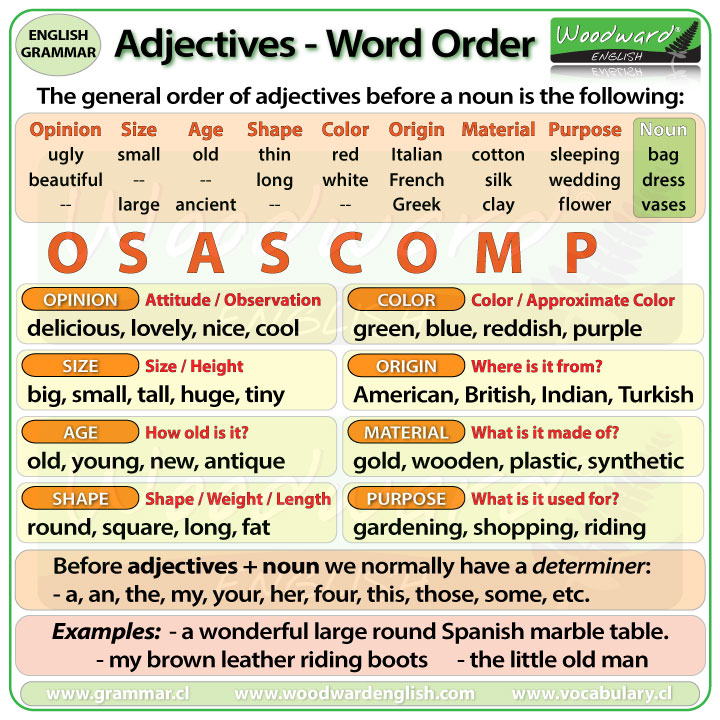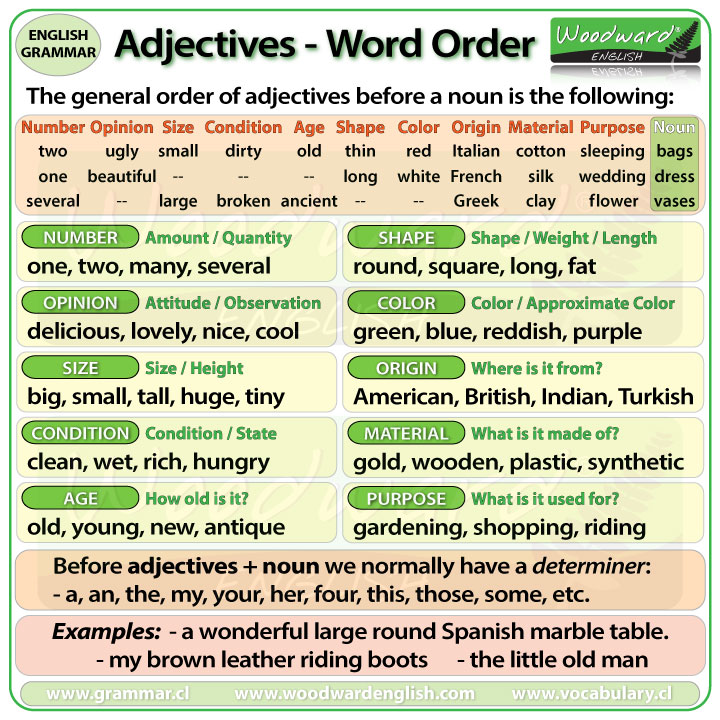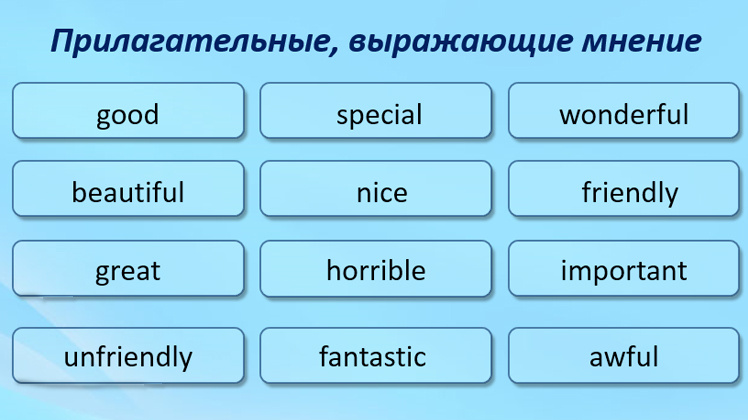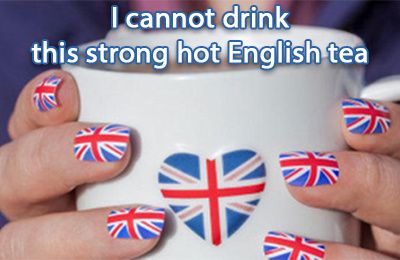What is an adjective?
An adjective is a word that describes something (a noun).
An adjective gives us more information about a person or thing.
Correct order of adjectives
Adjectives sometimes appear after the verb To Be (CARD – LINK TO VIDEO)
The order is To Be + Adjective.
- He is tall.
- She is happy.
Adjectives sometimes appear before a noun.
The order is Adjective + Noun.
- Slow car
- Brown hat
BUT… Sometimes you want to use more than one adjective to describe something (or someone).
What happens if a hat is both brown AND old?
Do we say… an old brown hat OR a brown old hat?
An old brown hat is correct because a certain order for adjectives is expected.
A brown old hat sounds incorrect or not natural.
So what is the correct order of adjectives before a noun?
The order of adjectives before a noun is usually the following:
Opinion – Size – Age – Shape – Color – Origin – Material – Purpose
If we take the first letter of each one, it creates OSASCOMP which is an easy way to remember the order.
Let’s look at an example about describing a bag.
- It is an ugly small old thin red Italian cotton sleeping bag
It is not common to have so many adjectives before a noun, but I do this so you can see the correct order of adjectives.
Ugly is an opinion, small is a size, old refers to age, thin refers to shape, red is a color, Italian refers to its origin, cotton refers to the material the bag is made of, sleeping is the purpose of the bag.
I will go into more details about each of these categories in a moment. First, let’s see two more examples:
- A beautiful long white French silk wedding dress.
- Large ancient Greek clay flower vases.
Let’s study the first one.
Here we have a dress. Dress is a noun, the name of a thing. Let’s describe this dress.
What type of dress is it? What is the purpose of this dress?
It is used for weddings so it is…
- a wedding dress.
Let’s image the dress is made of silk. It isn’t made of plastic or gold, it is made of silk.
Silk is a material so it goes before the purpose. We say it is:
- a silk wedding dress.
Now, this dress was made in France. France is a noun, its adjective is French.
Its origin is French. Its origin, French, goes before the material, Silk. So we say it is:
- a French silk wedding dress.
Let’s add the color of the dress. What color is it? White. Color goes before Origin so we say it is:
- a white French silk wedding dress.
What is the shape of this dress? Is it long or short? It is long. The adjective Long goes under the category of shape because shape also covers weight or length. (We will see more about this in a moment) We now say it is:
- a long white French silk wedding dress.
Let’s add one more adjective. Is the dress beautiful or ugly? Well, you should always say it is beautiful or it will ruin her wedding day.
Beautiful is an opinion and adjectives about opinions go before all the other adjectives. So our final description of the dress is:
- a beautiful long white French silk wedding dress.
Now of course we don’t normally add so many adjectives before a noun. This example is just to show you the order of adjectives.
The order is NOT fixed
IMPORTANT: The order of adjectives before a noun is NOT 100% FIXED.
This chart is only a guide and is the order that is preferred.
You may see or hear slight variations of the order of adjectives in real life though what appears in the chart is the order that is expected the most.
Now, let’s look at each type of adjective in more detail (with examples)…
Types of Adjectives
OPINION
Opinion: These adjectives explain what we think about something. This is our opinion, attitude or observations that we make. Some people may not agree with you because their opinion may be different. These adjectives almost always come before all other adjectives.
Some examples of adjectives referring to opinion are:
- delicious, lovely, nice, cool, pretty, comfortable, difficult
For example: She is sitting in a comfortable green armchair.
Comfortable is my opinion or observation, the armchair looks comfortable. The armchair is also green.
Here we have two adjectives. The order is comfortable green armchair because Opinion (comfortable) is before Color (green).
SIZE
Size: Adjectives about size tell us how big or small something is.
Some examples of adjectives referring to size are:
- big, small, tall, huge, tiny, large, enormous
For example: a big fat red monster.
Notice how big is first because it refers to size and fat is next because it refers to shape or weight. Then finally we have the color red before the noun.
AGE
Age: Adjectives of age tell us how old someone or something is. How old is it?
Some examples of adjectives referring to age are:
- old, young, new, antique, ancient
For example: a scary old house
Scary is my opinion, old refers to the age of the house. Scary is before old because opinion is before age.
SHAPE
Shape: Also weight and length. These adjectives tell us about the shape of something or how long or short it is. It can also refer to the weight of someone or something.
Some examples of adjectives referring to shape are:
- round, square, long, fat, heavy, oval, skinny, straight
For example: a small round table.
What is the shape of the table? It is round.
What is the size of the table? It is small.
The order is small round table because size is before shape.
COLOR
Color: The color or approximate color of something.
Some examples of adjectives referring to color are:
- green, blue, reddish, purple, pink, orange, red, black, white
(adding ISH at the end makes the color an approximate color, in this case reddish is “approximately red”)
Our example: a long yellow dress.
What is the color of the dress? It is yellow.
The dress is also long. Long which is an adjective of shape or more precisely length, is before an adjective of color.
ORIGIN
Origin: Tells us where something is from or was created.
Some examples of adjectives referring to origin are:
- American, British, Indian, Turkish, Chilean, Australian, Brazilian
Remember, nationalities and places of origin start with a capital letter.
For example: an ancient Egyptian boy.
His origin is Egyptian. Egyptian needs to be with a capital E which is the big E.
Ancient refers to age so it goes before the adjective of origin.
MATERIAL
Material: What is the thing made of or what is it constructed of?
Some examples of adjectives referring to material are:
- gold, wooden, plastic, synthetic, silk, paper, cotton, silver
For example: a beautiful pearl necklace
Pearl is a material. They generally come from oysters.
The necklace is made of what material? It is made of pearls.
The necklace is also beautiful so I put this adjective of opinion before the adjective referring to material.
PURPOSE
Purpose: What is it used for? What is the purpose or use of this thing? Many of these adjectives end in
–ING but not always.
Some examples of adjectives referring to purpose are:
- gardening (as in gardening gloves), shopping (as in shopping bag), riding (as in riding boots)
Our example: a messy computer desk
What is the purpose of the desk? It is a place for my computer, it is designed specifically to use with a computer. It is a computer desk. In this case, the desk is also very messy. Messy is an opinion. Some people think my desk is messy. So, the order is opinion before purpose.
So this is the general order of adjectives in English and you can remember them by the mnemonic OSASCOMP.
BUT did you know that we could add some extra categories?
BONUS ADJECTIVE GROUPS
We can add the adjective categories of Number and Condition.
NUMBER
Number: Tells us the amount or quantity of something.
It is not only for normal cardinal numbers like, one, two, three… but also other words that refer to quantity such as many or several.
Our examples of adjectives referring to numbers are:
- One, two, three, many, several
For example: three hungry dogs
Number adjectives go before all the other adjectives, including adjectives about opinion.
Hungry is a condition or state so the order is Three hungry dogs.
CONDITION
Condition: Tells us the general condition or state of something
Our examples of adjectives referring to condition or state are:
- Clean, wet, rich, hungry, broken, cold, hot, dirty
For example: Two smelly old shoes.
Smelly is a condition or state. Smelly is before old which refers to age. The number two is at the beginning as numbers always are.
Adjectives – Word Order – Summary Chart
Adjectives Word Order – Practice Quiz
Имя прилагательное – одна из основных частей речи. Она описывает те предметы, лица и явления, о которых мы говорим. Хорошо, когда имя существительное сопровождается каким-либо одним прилагательным, например:
- a young girl – молодая девушка;
- a black table – черный стол;
- an interesting book – интересная книга.
А что делать, если прилагательных, относящихся к слову, два, три или больше? Каков будет порядок прилагательных в английском языке, если мы сталкиваемся с такой ситуацией? Ответ на этот вопрос вы найдете в нашей статье.
Какие бывают прилагательные
Безусловно, английский – язык исключений и всевозможных поправок. Но он имеет определенный алгоритм, согласно которому все английские прилагательные занимают свое место перед существительным.
Все прилагательные можно разделить на две большие группы: субъективные (opinion adjectives) и объективные (fact adjectives). Первые отвечают за то, как мы воспринимаем тот или иной предмет (лицо или явление) и какую оценку ему даем. Вторая группа предоставляет реально существующую информацию о чем-либо, то есть то, с чем не поспоришь. Это может быть размер, цвет, возраст и т. д. Сначала мы ставим субъективное прилагательное, а затем объективное:
- an unusual gold ring – необычное (субъективное мнение) золотое (реальная информация) кольцо;
- a nice old lady – приятная (субъективное мнение) пожилая (реальная информация) дама;
- a lovely sunny day – чудесный (субъективное мнение) солнечный (реальная информация) день;
- a delicious hot soup – вкусный (субъективное мнение) горячий (реальная информация) суп;
- an interesting historical movie – интересный (субъективное мнение) исторический (реальная информация) фильм.
Порядок прилагательных в английском предложении
Усложняем ситуацию. До этого мы говорили лишь о двух прилагательных, стоящих перед именем существительным. Теперь разрабатываем план действий в ситуации с тремя и более прилагательными. Порядок объективных прилагательных в английском языке при наличии двух и более слов организован следующим образом:
- Общее качество (general quality), цена (price): new (новый), broken (поломанный), expensive (дорогой), cheap (дешевый).
- Размер (size): big (большой), small (маленький), tall (высокий), short (короткий, невысокий).
- Физические характеристики (physical quality): hard (твердый), fragile (хрупкий) rough (неровный), smooth (гладкий).
- Форма (shape): square (квадратный), round (круглый), triangular (треугольный), almond-shaped (миндалевидный).
- Возраст (age): young (молодой), old (старый), mature (зрелый), middle-aged (средних лет).
- Цвет (colour): red (красный), purple (фиолетовый), olive-green (оливковый), indigo (темно-синий).
- Происхождение (origin): Italian (итальянский), Mexican (мексиканский), European (европейский), Far Eastern (дальневосточный).
- Вещество (substance), материал (material): wooden (деревянный), bronze (бронзовый), tin (оловянный), plastic (пластмассовый).
- Предназначение, цель (purpose): work (рабочий), cleaning (чистящий), cooking (для готовки), sleeping (для сна).
* Пункты 4 и 5 могут меняться местами.
Теперь давайте посмотрим на примерах, как выстраиваются прилагательные в предложении. В примерах у каждого прилагательного есть цифра, совпадающая с его порядковым номером в списке. Цифрой 0 обозначены субъективные прилагательные.
Take a
box, it’s on the table. – Возьми
коробку, она на столе.
The rooms are divided by a
wall. – Комнаты разделены
стеной.
I’ve bought
plates! – Я купила
тарелки!
Так выглядит основной алгоритм, по которому выстраиваются прилагательные в английском предложении. И теперь еще несколько дополнений к нему:
- Прилагательные в сравнительной и превосходной степенях стоят перед всеми остальными.
At the ceremony there were some of the best young French actresses. – На церемонии присутствовало несколько лучших молодых французских актрис.
I’d like to buy a more beautiful ancient vase. – Я бы хотел купить более красивую древнюю вазу.
- Прилагательные ставятся после местоимений something, anybody, nothing.
There was something round and green in the corner. – В углу лежало что-то круглое и зеленое.
Nothing interesting or valuable was found during the expedition. – Ничего интересного или ценного не было найдено во время экспедиции.
- Прилагательные, показывающие меру (deep – глубиной, high – высотой, long – длиной, wide – шириной и т. д.), размещаются после определяемого существительного.
The highway is 10 kilometres long. – Эта трасса 10 километров длиной.
This lake isn’t big, but it is 30 metres deep. – Это озеро небольшое, но глубиной 30 метров.
В заключение посмотрите видео о порядке прилагательных в английском и пройдите тест, чтобы понять, насколько хорошо вы усвоили эту тему. А чтобы ничего не забыть, скачайте табличку-шпаргалку с очередностью прилагательных в предложении.
↓ Скачать таблицу с очередностью прилагательных в английском предложении (*pdf, 187 Кб)
Тест
Порядок прилагательных в английском языке
Расставьте прилагательные в правильном порядке
Задание 1.
In the art-gallery I saw
beautiful
multicolored
Italian
old
picture of a woman sitting on the coach.
Задание 3.
Yesterday Jim bought me a
bag.
Задание 4.
It is the most
old-fashioned
charming
evening
red
dress I have ever seen.
Задание 5.
Look at that nice
tablecloth! I want to buy it!
Задание 6.
Put on your
scarf. It’s cold outside.
Задание 7.
He wants to visit the exhibition of
European
strange
contemporary
art in the local museum.
Задание 8.
You should water the
flowers twice a month.
Задание 9.
I’ll gift her a
compact
self-cleaning
modern
grey
hoover.
Задание 10.
Take off this
old-fashioned
ugly
velvet
huge
pink
hat!
Тест недоступен для мобильных устройств.
Тест недоступен для мобильных устройств.
Если вы нашли ошибку, пожалуйста, выделите фрагмент текста и нажмите Ctrl+Enter.
Вы когда-нибудь задумывались, почему знаменитые названия little black dress / big brown bag содержат прилагательные именно в таком порядке, а не наоборот. Носителю русского языка будут резать слух словосочетания типа: «хороший девочка, дорогой посуда» или инфинитивы вместо личных форм «я купить туфли». Так, и носителю английского языка слух будут резать словосочетания вроде: black little dress или brown big bag, потому что у английских прилагательных, в отличии от русских, есть особый строгий порядок расположения перед существительным.
Opinion adjectives
Описывая существительные, мы пользуемся прилагательными, которые выражают наше мнение (opinion adjectives) и фактическими или объективными прилагательными, которые описывают очевидные факты о существительном: возраст, цвет, материал и т.д. (factual adjectives).
Прилагательное, выражающее субъективное мнение всегда занимает первое место.
Примеры предложений
- What a wonderful ring!
- Какое прекрасное кольцо!
- My brother got a brilliant experience in China.
- Мой брат получил замечательный опыт в Китае.
- That café serves a delicious soup.
- В том кафе подают вкусный суп.
Примеры предложений
- What a wonderful golden ring!
- Какое прекрасное золотое кольцо!
- My brother got a brilliant teaching experience in China
- Мой брат получил замечательный педагогический опыт в Китае.
- That café serves a delicious hot vegetable soup
- В том кафе подают вкусный горячий овощной суп
Fact adjectives
Когда в предложении употребляется больше одного фактического прилагательного, то следует придерживаться определенного порядка, например:
a fantastic new French perfume (opinion+age+origin)
my lovely warm old green jumper (opinion+quality+age+colour)
an enormous new sports stadium (size+age+purpose)
Примеры предложений
- We stayed in a beautiful ancient Scottish castle for a week.
- Мы останавливались в красивом старинном Шотландском замке.
- It’s a real Japanese fishing boat.
- Это настоящая японская рыболовная лодка.
- Do you really need expensive silver golf shoes?
- Тебе действительно нужны дорогие серебристые ботинки для гольфа?
- We’ve bought fast yellow family car.
- Мы купили быстрый желтый семейный автомобиль.
- An interesting new science-fiction film is coming out this week.
- Интересный новый научно-фантастический фильм выходит на этой неделе.
- I have never seen such sweet little black puppies.
- Никогда не видел таких милых маленьких черных щенков.
Comparatives and superlatives
Если наряду с перечисленными выше прилагательными, появляется прилагательное в сравнительной или превосходной степени, оно занимает место перед всеми остальными прилагательными.
Примеры предложений
- He advertised the most expensive Swiss watch.
- Он рекламировал самые дорогие швейцарские часы.
- She was wearing the most fashionable red silk dress.
- Она была одета в самое модное красное шелковое платье.
- I need a glass of the freshest squeezed orange juice
- Мне нужен стакан самого свежего выжатого апельсинового сока.
|
|
|
Watch the video on Order of Adjectives
Пройти бесплатный урок английского языка
Ваша заявка принята
Наш менеджер свяжется с Вами в ближайшее время
При отправке возникла ошибка
Отправить еще раз









